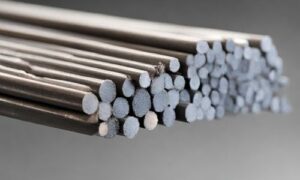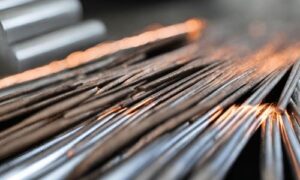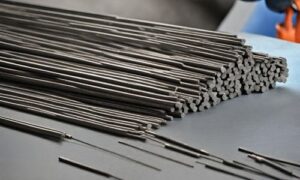Table of Contents
- Do welding rod go bad?
- 1. A Comprehension of Welding Rod deterioration
- 3. Impact of Deterioration
- 4. Effects of Moisture on Different Rod Types
- 5. Preventative Measures
- 6. Storage Guidelines
- 7. Handling Expired Rods
- 8. Re-drying Procedures for Different Rod Types
- 9. Welding Wire Concerns
- 10. Specific Rod Types and Shelf Life
- Conclusion
- FAQs about Do welding rod go bad?
Have you ever wondered if welding rods have a shelf life? Or if they can go wrong? The truth is, yes, they can. Understanding why and how welding rods deteriorate is crucial for anyone in the welding game.
This article dives into the causes, effects, and preventive measures surrounding this issue. Stay tuned to learn how to ensure your welding rods stay in top-notch condition for impeccable welds.
Do welding rod go bad?
Yes, welding rods can go bad over time. Multiple factors influence the shelf life of welding rods, and understanding these factors is vital for welders who want to ensure the quality of their welds.
1. A Comprehension of Welding Rod deterioration
Despite their sturdy appearance, welding rods are susceptible to deterioration over time. This degradation is often influenced by several factors, primarily environmental conditions and the inherent properties of the rods themselves.
The core reason behind welding rod deterioration lies in their composition. These rods typically consist of a metal core coated with flux. Exposure to elements like moisture, air, and contaminants can break this flux coating, rendering the rodless ineffective.
Moreover, the chemical reactions induced by exposure to environmental factors can impact the structural integrity of the rod. This could result in brittleness, reduced conductivity, or changes in the rod’s chemical composition, affecting its welding properties.
Understanding these fundamental processes is essential because it underscores the need to handle and store welding rods properly. Without such care, even the highest-quality rods can degrade prematurely, impacting weld quality and safety.
2. Factors Behind Deterioration
Several key factors contribute to the degradation of welding rods, ultimately impacting their effectiveness and lifespan.
- Moisture Exposure: Moisture is a primary culprit behind welding rod deterioration. It infiltrates the flux coating, causing it to break down and compromise the rod’s integrity. This is particularly problematic for low hydrogen electrodes, which are highly moisture-sensitive.
- Air and Contaminants: Exposure to air and contaminants can also accelerate the degradation process. Oxygen and other gases in the atmosphere react with the flux coating, leading to oxidation and corrosion. Contaminants such as dirt or chemicals can further exacerbate these effects.
- Temperature Variations: Extreme hot and cold temperatures can impact welding rods. High temperatures may cause the flux coating to soften or melt, altering its composition. On the other hand, cold temperatures can make the rods more brittle and susceptible to cracking.
- Handling and Storage Practices: Improper handling and storage can significantly contribute to deterioration. Rough handling, exposure to direct sunlight, or leaving rods exposed to the elements can expedite their degradation.
- Chemical Composition: The inherent composition of welding rods, particularly the flux coating, plays a crucial role. Different types of rods have varying compositions, making some more resilient to certain factors than others. For instance, low-hydrogen electrodes are susceptible to moisture compared to non-low-hydrogen variants.
Understanding these contributing factors is vital in adopting preventive measures to mitigate welding rod deterioration. By addressing these elements, welders can take proactive steps to preserve the quality and effectiveness of their welding rods.
3. Impact of Deterioration
The deterioration of welding rods can significantly affect the quality, safety, and efficiency of the welding processes.
- Weld Quality: Deteriorated welding rods directly impact the quality of welds produced. The breakdown of the flux coating or changes in the rod’s composition can result in inconsistent welds, porosity, or even weld defects. This compromises the structural integrity of the welded joints, posing potential safety hazards.
- Performance Issues: As welding rods deteriorate, their conductivity and arc stability can be compromised. This leads to fluctuations in arc characteristics, affecting the welding process’s control and precision. Welders may experience difficulty striking and maintaining an arc, impacting their ability to create precise and clean welds.
- Safety Concerns: Deteriorated welding rods pose safety risks. Weak welds due to degraded rods may fail under stress or pressure, potentially causing accidents or structural failures. Moreover, inconsistent weld quality resulting from deteriorated rods can compromise welded structures’ overall safety and reliability.
- Operational Costs: Using deteriorated welding rods can lead to increased operational costs. Rejected welds due to poor quality may necessitate rework, consuming additional time and resources. Moreover, the need to replace failed welds or structures due to compromised integrity further adds to the overall project expenses.
- Productivity Impact: Deteriorated rods can affect productivity by causing delays in welding operations. Welders may spend additional time troubleshooting issues arising from poor weld quality, impacting project timelines.
Understanding the wide-ranging impact of welding rod deterioration emphasizes the critical need for proper maintenance, handling, and storage practices. By ensuring the integrity of welding rods, welders can uphold high standards of quality, safety, and efficiency in their welding endeavours.
4. Effects of Moisture on Different Rod Types
Moisture poses a significant threat to welding rods, affecting low-hydrogen and non-low-hydrogen electrodes differently.
- Low Hydrogen Electrodes: These rods are highly susceptible to moisture. Even minimal exposure can compromise their effectiveness. The hydrogen introduced by moisture can lead to hydrogen-induced cracking in the weld metal, causing weld defects and reduced mechanical properties. Proper storage and handling are critical for these electrodes to maintain their low hydrogen content.
- Non-Low Hydrogen Electrodes: While non-low hydrogen electrodes are less sensitive to moisture than their low hydrogen counterparts, they are not immune. Excessive moisture exposure can still cause issues, albeit to a lesser extent. Contaminants introduced by moisture can affect the quality of the welds, leading to potential defects and reduced weld integrity.
Understanding the distinct vulnerabilities of these electrode types to moisture underscores the necessity of stringent storage and handling practices. Proper storage in designated dry environments and adherence to manufacturer-recommended guidelines is imperative to prevent moisture-related degradation of welding rods, ensuring optimal performance during welding operations.
5. Preventative Measures
Implementing preventive measures is crucial to mitigate welding rod deterioration and ensure its longevity and effectiveness.
- Storage Conditions: Store welding rods in a dry, controlled environment away from moisture, extreme temperatures, and contaminants. Utilize sealed containers or rod ovens to maintain optimal conditions, especially for low hydrogen electrodes.
- Proper Handling: Exercise care when handling welding rods. Avoid dropping or striking them against hard surfaces, damaging the flux coating and compromising their integrity.
- Adherence to Guidelines: Follow manufacturer guidelines regarding the storage, handling, and shelf life of welding rods. Different types of rods may have specific storage requirements, and adherence to these recommendations is essential to maintain their quality.
- Re-drying Procedures: For electrodes sensitive to moisture, such as low-hydrogen types, employ re-drying procedures if exposed to atmospheric conditions. Use designated ovens set to specific temperatures and durations recommended by the manufacturer to remove moisture before use.
- Regular Inspection: Inspect welding rods for any signs of damage or contamination. Discard any rods showing signs of degradation or compromise to prevent compromised weld quality.
- Labelling and Rotation: Properly label and rotate welding rod stocks to ensure the use of the oldest rods first. This helps prevent rods from exceeding their shelf life and ensures optimal performance.
By implementing these preventive measures, welders can significantly extend the lifespan and maintain the integrity of welding rods, ultimately enhancing the quality and safety of welding operations.
6. Storage Guidelines
Proper storage of welding rods is critical to preserving their integrity and preventing premature deterioration. Understanding and adhering to specific storage guidelines for different electrode types is essential.
- Low-Hydrogen Electrodes: These electrodes are extremely sensitive to moisture. Store them in dedicated rod ovens set at specified temperatures to maintain a low hydrogen content. Keep them sealed in moisture-resistant packaging until use.
- Non-Low-Hydrogen Electrodes: While less moisture-sensitive, these electrodes still require careful storage. Store them in a dry environment away from moisture and contaminants. Sealed containers or rod storage cabinets can help maintain their quality.
- Temperature Control: Avoid exposing welding rods to extreme temperatures. High temperatures can soften or damage the flux coating, while low temperatures can make rods more brittle and prone to cracking.
- Avoid Contamination: Protect welding rods from exposure to dirt, chemicals, or other contaminants. Keep them sealed in their original packaging or designated containers until they are ready for use.
- Shelf Life Monitoring: Regularly monitor and track the shelf life of welding rods. Label them with their purchase or production date, and use the oldest rods first to prevent expiration.
- Adherence to Manufacturer Guidelines: Follow manufacturer recommendations regarding storage conditions, including temperature ranges, humidity levels, and duration of storage. These guidelines are specific to each type of welding rod and are crucial for maintaining their quality.
Adhering to these storage guidelines ensures that welding rods remain in optimal condition for use, minimizing the risk of degradation and ensuring consistent weld quality and performance.
7. Handling Expired Rods
Dealing with welding rods that have deteriorated or expired requires specific procedures to ensure safety and prevent compromised weld quality.
- Identification: Regularly inspect welding rods for signs of deterioration or expiration. Look for indications such as rust, discolouration, flaking flux, or brittleness. Any rods exhibiting these signs should be considered expired or compromised.
- Segregation: Separate expired or deteriorated rods from usable ones to prevent accidental use. Properly label and quarantine these rods to avoid confusion or accidental use in welding operations.
- Disposal: Dispose of expired or compromised rods following recommended procedures. Contact local waste management facilities or recycling centres to ascertain proper disposal methods, as welding rods may contain materials that require specialized handling.
- Replacement: Ensure timely replacement of expired or compromised rods to maintain a ready supply of quality welding materials. Adhere to inventory management practices that prioritize using the oldest stock first to prevent the expiration of unused rods.
- Documentation: Maintain records of expired rods, including their type, quantity, and expiration date. This documentation aids in inventory management and ensures safety and disposal regulations compliance.
Handling expired or deteriorated welding rods responsibly is crucial to upholding welding quality, worker safety, and environmental standards. By following proper identification, segregation, disposal, and documentation protocols, welders can maintain a safe and efficient working environment while ensuring the use of high-quality welding materials.
8. Re-drying Procedures for Different Rod Types
Re-drying welding rods is crucial, especially for electrodes sensitive to moisture. Proper re-drying procedures help restore the integrity of rods that have been exposed to atmospheric conditions, ensuring their effectiveness in welding operations.
-
Low Hydrogen Electrodes
Place the affected low hydrogen electrodes in a designated rod oven set to the manufacturer’s recommended temperature.
Typically, these ovens maintain temperatures between 250°F to 400°F (120°C to 200°C) for a specified duration, usually ranging from 1 to 4 hours.
Ensure a gradual heating and cooling process to prevent thermal shock, which could further damage the rods.
Monitor the temperature and duration accurately, adhering strictly to the manufacturer’s guidelines to avoid overheating or under-drying the electrodes.
-
Non-Low Hydrogen Electrodes:
While non-low hydrogen electrodes are less sensitive, re-drying may still be necessary if exposed to moisture.
Follow similar re-drying procedures as for low hydrogen electrodes, but at slightly lower temperatures and shorter durations.
Manufacturer guidelines typically suggest temperatures ranging from 200°F to 300°F (95°C to 150°C) for 1 to 2 hours, but specific recommendations may vary.
-
Gradual Cooling and Storage:
After re-drying, allow the welding rods to cool gradually to room temperature before storage or use.
Store the re-dried electrodes in airtight containers or rod ovens to prevent re-absorption of moisture until they are ready for use.
-
Avoid Overheating:
It’s critical to avoid overheating the electrodes during re-drying, as excessive heat can alter the rod’s composition and affect welding performance.
Strictly adhere to the recommended temperature and duration specified by the manufacturer to ensure optimal reconditioning without damaging the rods.
Re-drying procedures are essential to restore the integrity of moisture-sensitive welding rods. Adhering meticulously to manufacturer guidelines during the re-drying process ensures that the rods maintain their optimal performance and contribute to consistent, high-quality welds.
9. Welding Wire Concerns
In addition to welding rods, welding wire is essential in welding processes. Understanding its expiration and handling is crucial for maintaining weld quality.
-
Expiration of Welding Wire
Welding wire, like welding rods, has a shelf life. It can degrade over time due to exposure to environmental elements, moisture, or improper storage conditions.
While some wires may have longer shelf life than rods, it’s essential to check manufacturer guidelines for specific expiration details.
-
Storage Guidelines for Welding Wire
Store welding wire in a dry, controlled environment away from moisture, dust, and contaminants.
Use sealed containers or spool holders to protect the wire from exposure to air and maintain its integrity.
-
Handling Practises
Handle welding wire carefully to prevent damage to the spool or wire itself. Avoid dropping or mishandling that could cause kinks or deformities in the wire.
Use appropriate feeding mechanisms and ensure smooth wire delivery during welding to maintain consistent performance.
-
Preventative Maintenance
Periodically inspect welding wire for any signs of damage or degradation. Replace wire that shows signs of rust, corrosion, or physical damage.
Adhere to recommended practices for storing, handling, and using welding wire specified by the manufacturer.
-
Wire Compatibility with Welding Equipment
Ensure the welding wire is compatible with the welding equipment being used. Different wire types may require specific settings or equipment for optimal weld quality.
By following proper storage, handling, and inspection practices, welders can extend the lifespan of welding wire and maintain its quality. This contributes to consistent and high-quality welds, ensuring the efficiency and safety of welding operations.
10. Specific Rod Types and Shelf Life
Different welding rods have varying shelf life, and understanding these specifics is essential for maintaining their effectiveness.
-
Low-Hydrogen Electrodes
These electrodes are susceptible to moisture and have a limited shelf life. Typically, they have a shelf life ranging from 6 months to 2 years, depending on storage conditions and manufacturer specifications.
Proper storage in rod ovens or sealed containers can extend their shelf life, but monitoring and adhering to manufacturer recommendations for maximum effectiveness is crucial.
-
Non-Low Hydrogen Electrodes
Non-low hydrogen electrodes have a longer shelf life compared to low hydrogen types. They generally maintain effectiveness for around 18 months to 3 years, again contingent on proper storage and handling.
While less sensitive to moisture, it’s still essential to maintain suitable storage conditions to maximize their shelf life.
- Storage Conditions Impacting Shelf Life
Factors such as temperature, humidity, and exposure to contaminants significantly impact the shelf life of welding rods.
Maintaining consistent and controlled storage conditions, adhering to temperature and humidity guidelines, and protecting rods from contaminants is crucial for maximizing their shelf life.
- Monitoring shelf life
Keep track of the purchase or production date of welding rods. Implement a system that ensures the oldest rods are used first to prevent expiration.
Regularly inspect and assess the condition of welding rods to identify any signs of degradation or expiration.
- Manufacturer Guidelines:
Adhere strictly to manufacturer guidelines regarding shelf life, storage conditions, and handling recommendations for each specific type of welding rod.
These guidelines are tailored to each type of rod and are crucial in maintaining their effectiveness and preventing premature deterioration.
Understanding the shelf life variations among different welding rod types and diligently adhering to storage and handling guidelines prescribed by manufacturers ensures that welders consistently use rods at their peak performance, minimizing the risk of degraded weld quality.
Conclusion
In conclusion, welding rods can deteriorate over time due to moisture, temperature, contaminants, and physical damage. To ensure the quality and safety of your welding projects, storing and handling welding rods properly is crucial.
By following the guidelines in this article, you can extend the shelf life of your welding rods and consistently achieve solid and reliable welds. Always prioritise safety and quality in your welding endeavours.
FAQs about Do welding rod go bad?
Can I use welding rods past their expiration date?
It’s not recommended. Expiration dates are there for a reason, and using expired welding rods can lead to poor weld quality.
What should I do if I suspect my welding rod is bad?
Discard it and use a new one. It’s better to be safe than sorry when it comes to welding quality and safety.
Can I store welding rods in my garage?
Only if your garage provides a dry and temperature-controlled environment. Otherwise, it’s best to find an alternative storage solution.
How can I prevent flux cracking on welding rods?
Proper storage and handling are key. Keep the rods dry and avoid subjecting them to physical stress.
Can I extend the shelf life of welding rods in any way?
Yes, by following the storage and handling guidelines mentioned in this article, you can extend the shelf life of your welding rods.




2 thoughts on “Do Welding Rod Go Bad?”